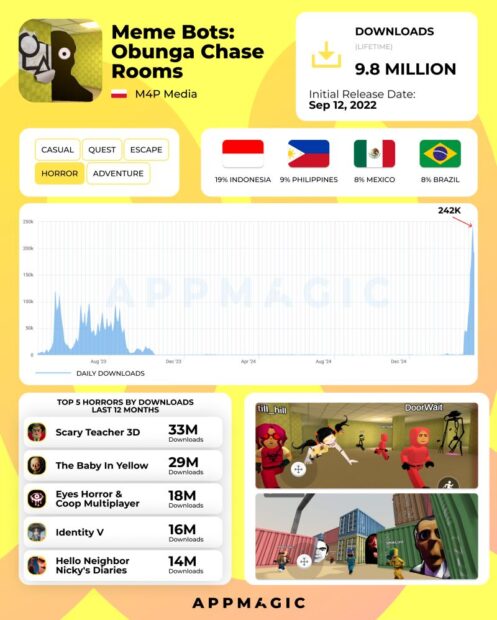
- arrow_back Home
- keyboard_arrow_right Highlights
Long Ads, Tiny Close Buttons: Maximize CPM Without Losing Players
HighlightsJournal 21 Ezgi Dogan April 9

You’ve spent hours crafting a beautiful game that hooks players, but now it’s time to make money.
The tiny, tiny close button — often hidden in the farthest corner of the screen — is a seemingly innocent little dot that holds the fate of your game’s retention and monetization. Every time an interstitial ad pops up, it takes multiple taps, finger gymnastics, and maybe even some squinting.
As the ads get longer, your players’ frustration grows. They’re desperate to close the ad, but hey—your CPM is up! It seems like a win, right?
But here’s the big question:
How long can you really stretch those ads, and how tiny can that close button be, before your players hit their breaking point and rage quit? It’s a tricky balancing act, like playing with fire—walking a fine line between keeping the revenue flowing and not driving your players away.
The reality is, this balancing act is crucial for game monetization.
And this leads to a broader trend you’ve probably noticed: ads, for both interstitial and rewarded, are getting longer and looooonger. In some cases, players are stuck watching for 60 seconds—or even 120 seconds!—just to finish a rewarded ad, even though we aim for around 30 seconds. For those of us developing hyper/hybrid casual games, common templates like 5+3+2 or 5+5+instant skip for interstitials might be assumed like the standard, but are they really optimized for both CPM and player retention? And when it comes to rewarded videos, how much does tweaking ad templates actually impact CPM?
After running a ton of tests across different game genres and experimenting with ad formats, I’ve uncovered some key insights, and here I am to share them with you. Sometimes, adjusting the ads barely affects CPM, but other times, it can drop as much as 20%. So, what’s the sweet spot when it comes to interstitial and rewarded ads—where you can keep both your players happy and your profits steady?
In the chapters ahead, I’ll walk you through the best practices I’ve discovered, including ad settings that help maintain solid CPMs and a few unexpected tips that can actually improve the player experience without hurting your bottom line.
Ready to dive in? Let’s get started!
Interstitial Ad Best Practices
For interstitial ads, here’s what I recommend:
- Don’t limit the total duration of the ad, but focus on when the ad becomes skippable.
- The best practice is to make the ad skippable after 5 seconds.
But here’s the catch: many ads now have two separate end cards (the regular end card and an auto-generated end card), and each of these has its own skippable time. To keep things smooth, I suggest a 5-second skippable time, followed by an instant skip for the end cards. This way, the total skippable duration is still just 5 seconds, giving users a better experience without sacrificing too much from ad revenue.
Rewarded Ad Best Practices
Rewarded ads are different because users actively choose to watch them. There are two main options:
- Limit the ad duration to 30 seconds.
- Allow ads to become skippable after 30 seconds, including end cards (which typically last around 5 seconds).
I recommend the second option. Why?
Because allowing longer rewarded ads can really increase demand from advertisers, which can lead to significantly higher CPMs, especially for networks that aren’t yet strong in the rewarded ad space.
Exploring Other Options For Your Title
There are several other ways you can manage interstitial and rewarded ads:
- Make interstitial ads skippable by default to prioritize user experience. But remember, this could lower revenue, as users tend to skip more often—expect up to a 20% drop in CPMs.
- Opt for static interstitial ads instead of videos. Static interstitials can be closed immediately, but the trade-off is significantly lower revenue, with most demand coming from networks like Google or Amazon for non-video ads.
- Shorten rewarded ad durations to a maximum of 15 seconds. This improves user experience but may reduce CPMs, as fewer advertisers will bid for shorter ad slots.
Ultimately, the best approach depends on your game’s audience, so it’s important to test and find what works best for your specific title.
Muting Ads for a Better User Experience
One last tip for improving player experience: mute ads by default.
Almost all ad networks allow this, and it’s a great way to avoid awkward moments when a loud ad plays unexpectedly, whether in a quiet place or with the user’s volume cranked up high.
I’ve tested this across several games, and muting ads by default has never negatively impacted revenue. It’s a simple tweak that can make the ad experience much less intrusive for your players.
Looking for more details?
I’ve put together a – gooood – document that outlines the default skippable times and ad durations for both interstitial and rewarded ads across the top 15 ad networks, as well as how to control and customize these settings.







